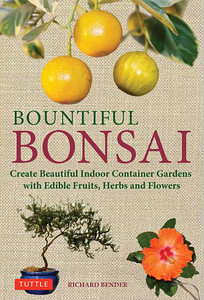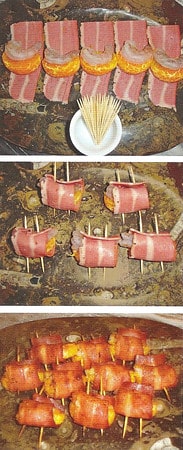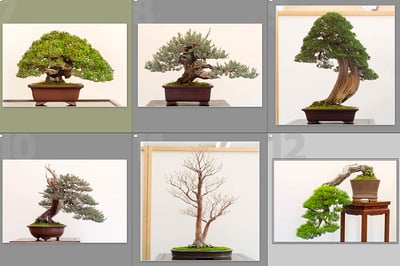Bountiful Bonsai: Create Instant Indoor Container Gardens with Edible Fruits, Herbs and Flowers, by Richard W. Bender. Tuttle Publishing, 128 pp., $14.95. Available from Tuttle.
Interested in growing more of what you eat? Is your primary growing space indoors or otherwise sheltered from the elements? If so, check out Bountiful Bonsai by Richard Bender.

Bountiful Bonsai by Richard Bender
Bountiful Bonsai is a recent release from Tuttle Publishing. Tuttle is well known for publishing quality books on Asian culture, including 1957’s Miniature Trees and Landscapes by Yuji Yoshimura and Giovanna M. Halford – one of the first popular bonsai books in the United States. Tuttle’s catalog includes a number of books on bonsai, the most recent of which is the present offering. (Full disclosure: the publisher provided me with a review copy of the book.)
The author, Richard Bender, has operated a Colorado bonsai nursery, Bonsai By Bender, for over 20 years, and is the author of a related title, Herbal Bonsai, published by Stackpole Books in 1996.
Bender’s knowledge of trees that produce fruit, oils, fragrance or leaves for tea-making is impressive. If you’re curious about producing alternative wines, you may appreciate Bender’s use of wine-making ingredients ranging from lavender and thyme to jasmine and hibiscus flowers to blood orange and kumquat. Bountiful Bonsai provides inspiration for jams, jellies and chutneys made from home-grown limequat, guava and rosemary and it includes recipes too.

Bacon-Shrimp Citrus Wraps
The bulk of the book is devoted to growing tips for recommended varieties from avocado, black olive and carob through rosemary, strawberry guava and thyme. The care tips focus on fruit production in indoor or greenhouse settings and convey significant experience in the nursery and in the kitchen.
It’s kind of awesome how much food knowledge is packed into the book. It would have been nice to see a bit more information about techniques for pruning and repotting for readers who are new to container gardening, but all in all it’s a great starting point for alternative wine-makers, tea-drinkers and citrus-lovers.
Photo quality is variable; the text is clear and well-written. The book itself is beautifully laid out and is printed on high-quality paper. It will make a nice addition to my (meager) horticulture/culinary library.
That said, what I found myself wondering at times was how to answer a simple question about the book – is this bonsai?
Bender speaks to the question while writing about the trade-offs between artistic merit and fruit production:
We are changing the philosophy here from trying to create the “ideal” ornamental bonsai to a compromise between perfect form and bountiful harvests. In my opinion, the attractiveness of the flowers or fruit overshadows any short-term imperfections in form. Not everyone agrees: try displaying a large blooming rosemary or a variegated calamondin orange with flowers and ripe fruit at a Bonsai Society show. A few other exhibitors will start muttering to each other about the imperfections in your bonsai. You might even hear, “This is not real bonsai!” Meanwhile, the largest crowd in the show, including many of the other exhibitors, will be gathered around your specimen oohing and ahhing, saying, “This is the neatest bonsai I’ve ever seen!” (107-8)
I sympathize with the sentiment that if the goal is to produce results at the table, the focus can go to food production instead of form.
Take full advantage of every feature when you display your edible bonsai. Serve a tea made from its foliage, perhaps with limequat marmalade (from another bonsai) on crackers. Plan a dinner party with a bonsai theme using foliage and/or fruit from your various bonsai in every course, from wine to dessert, with your prized bonsai as the centerpiece. Consuming part of your art while it continues to flourish, grow, and change carries it to a unique new level. (108)
But is this bonsai? Comparing the book’s photos with some randomly selected recent photos in my album reveals a significant stylistic gap, but this gap says more about the trade-off between growing trees for fruit production versus display-focused bonsai.

Photos from Bountiful Bonsai

Photos from Bay Island Bonsai’s 2015 exhibit
No matter. What’s clear is that Bender has a lot to offer and that Tuttle’s done a great job putting it together. Don’t expect refined styling advice, but don’t be surprised by the Strawberry Lemon Guava wine either.
For an additional perspective, see Adam Lavigne’s review at Adam’s Art and Bonsai Blog.
And do enjoy the Book Trailer for Bountiful Bonsai on You Tube.
Subscribe to Bonsai Tonight
New Posts Delivered Every Tuesday and Friday
backcountrydan says
Very interesting. What are your thoughts on the soil used, pertaining to fruit production? Would good “bonsai” soil like “Boon’s Mix” with heavy feed produce any less fruit than the potting soil he’s using?
Jonas Dupuich says
Great question. When I think of the soil retail nurseries use and recommend, the book’s advice is in line with that. To encourage fruit production, I’d recommend the appropriate fertilizer and as much light as possible.
Good bonsai soil could likely be used to even better effect, and I’d recommend it for more serious enthusiasts.
thomdec says
What are your thoughts regarding French Lavender as bonsai? Although older plants are very brittle they can have some very interesting shapes, trunks and limbs. I have a 6+ year old plant that I have just started to experiment / work on. I’ve read they are not long-lived, but I’m not sure. Worth the time? Any suggestions / recommendations? Thanks.
Jonas Dupuich says
Good question about the lavender – I’ve seen young trees with some character but I don’t know if they can be developed over longer periods of time. I think of them as a good perennial.
Thomdec says
Thank you. It already has an interesting treelike look and the bees and hummingbirds love it. As is, it’s a nice accent plant so I’ll let nature take is course.
bender1889 says
French lavender makes a great bonsai and can thrive for years. I discuss it in the book. The oldest wine in my cellar is a 1986 French Lavender wine made from bonsai trimmings.
thomdec says
Thanks. I enjoyed your video and will pick up a copy of your book to add to my library. I also have a 10 year old dwarf Meyer lemon tree I have been thinking about training. Over the years the fruit has become smaller and I believe the tree has also reached its maximum height. I don’t recall seeing any citrus displayed in bonsai expositions. Can they be trained to show?
bender1889 says
Thank you. If you want a show bonsai to have a more traditional appearance, I would recommend using a small variety like kumquat or Calamondin orange. The fruit and leaves are smaller than the larger citrus and have a better scale for show bonsai. These varieties in my experience are also easier to grow indoors and more prolific than larger fruited citrus. I have seen these smaller citrus in shows and if they have flowers and/or fruit they will attract more attention than any other bonsai in the show.
Jonas Dupuich says
Yep, citrus can make great bonsai – they regularly show up in some of the best shows:
http://dupuich.smugmug.com/Japan-2014/Bonsai-pics/Kokufu/i-DTFxGR4
http://dupuich.smugmug.com/Japan2011/Bonsai-pics/Gomangoku/i-vfch47Q
http://dupuich.smugmug.com/Japan2011/Bonsai-pics/2011-Taikan-ten/i-4MCmchB
Veronica says
I have a calamondin right now that I intend to train the the future. The great thing about this citrus is that, while the flesh of the fruit is sour, the peel is sweet, and not bitter at all. If anyone here has tried vodka citrus infusions, you’ll know how GREAT that is!